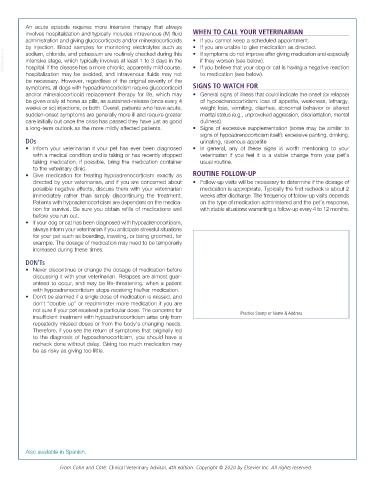Page 3041 - Cote clinical veterinary advisor dogs and cats 4th
P. 3041
An acute episode requires more intensive therapy that always
involves hospitalization and typically includes intravenous (IV) fluid WHEN TO CALL YOUR VETERINARIAN
administration and giving glucocorticoids and/or mineralocorticoids • If you cannot keep a scheduled appointment.
by injection. Blood samples for monitoring electrolytes such as • If you are unable to give medication as directed.
VetBooks.ir intensive stage, which typically involves at least 1 to 3 days in the • If you believe that your dog or cat is having a negative reaction
• If symptoms do not improve after giving medication and especially
sodium, chloride, and potassium are routinely checked during this
if they worsen (see below).
hospital. If the disease has a more chronic, apparently mild course,
hospitalization may be avoided, and intravenous fluids may not to medication (see below).
be necessary. However, regardless of the original severity of the
symptoms, all dogs with hypoadrenocorticism require glucocorticoid SIGNS TO WATCH FOR
and/or mineralocorticoid replacement therapy for life, which may • General signs of illness that could indicate the onset (or relapse)
be given orally at home as pills, as sustained-release (once every 4 of hypoadrenocorticism: loss of appetite, weakness, lethargy,
weeks or so) injections, or both. Overall, patients who have acute, weight loss, vomiting, diarrhea, abnormal behavior or altered
sudden-onset symptoms are generally more ill and require greater mental status (e.g., unprovoked aggression, disorientation, mental
care initially but once the crisis has passed they have just as good dullness).
a long-term outlook as the more mildly affected patients. • Signs of excessive supplementation (some may be similar to
signs of hypoadrenocorticism itself): excessive panting, drinking,
DOs urinating, ravenous appetite
• Inform your veterinarian if your pet has ever been diagnosed • In general, any of these signs is worth mentioning to your
with a medical condition and is taking or has recently stopped veterinarian if you feel it is a visible change from your pet’s
taking medication; if possible, bring the medication container usual routine.
to the veterinary clinic.
• Give medication for treating hypoadrenocorticism exactly as ROUTINE FOLLOW-UP
directed by your veterinarian, and if you are concerned about • Follow-up visits will be necessary to determine if the dosage of
possible negative effects, discuss them with your veterinarian medication is appropriate. Typically the first recheck is about 2
immediately rather than simply discontinuing the treatment. weeks after discharge. The frequency of follow-up visits depends
Patients with hypoadrenocorticism are dependent on the medica- on the type of medication administered and the pet’s response,
tion for survival. Be sure you obtain refills of medications well with stable situations warranting a follow-up every 4 to 12 months.
before you run out.
• If your dog or cat has been diagnosed with hypoadrenocorticism,
always inform your veterinarian if you anticipate stressful situations
for your pet such as boarding, traveling, or being groomed, for
example. The dosage of medication may need to be temporarily
increased during these times.
DON’Ts
• Never discontinue or change the dosage of medication before
discussing it with your veterinarian. Relapses are almost guar-
anteed to occur, and may be life-threatening, when a patient
with hypoadrenocorticism stops receiving his/her medication.
• Don’t be alarmed if a single dose of medication is missed, and
don’t “double up” or readminister more medication if you are
not sure if your pet received a particular dose. The concerns for
insufficient treatment with hypoadrenocorticism arise only from Practice Stamp or Name & Address
repeatedly missed doses or from the body’s changing needs.
Therefore, if you see the return of symptoms that originally led
to the diagnosis of hypoadrenocorticism, you should have a
recheck done without delay. Giving too much medication may
be as risky as giving too little.
Also available in Spanish.
From Cohn and Côté: Clinical Veterinary Advisor, 4th edition. Copyright © 2020 by Elsevier Inc. All rights reserved.

